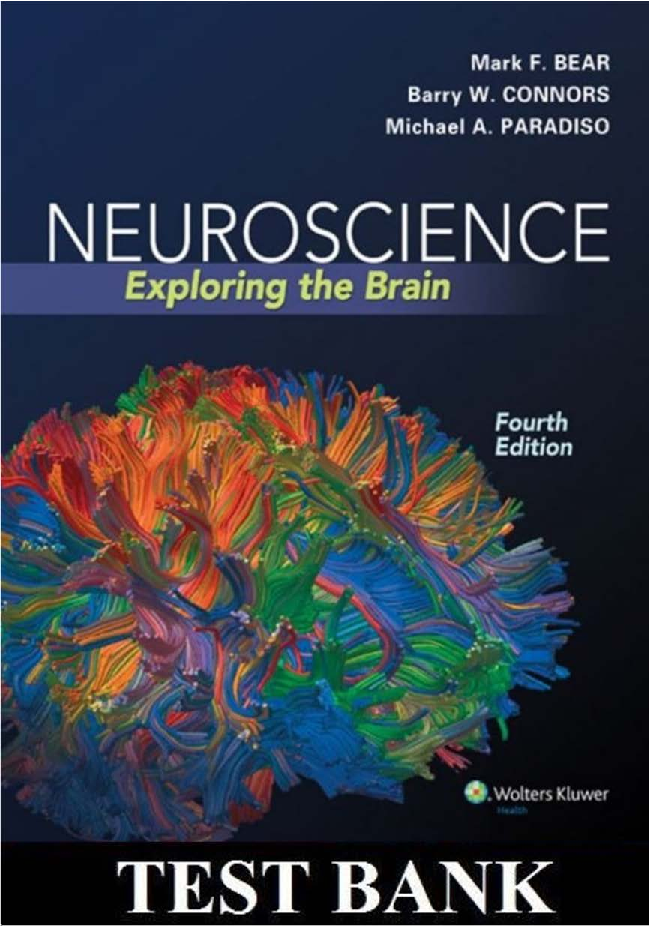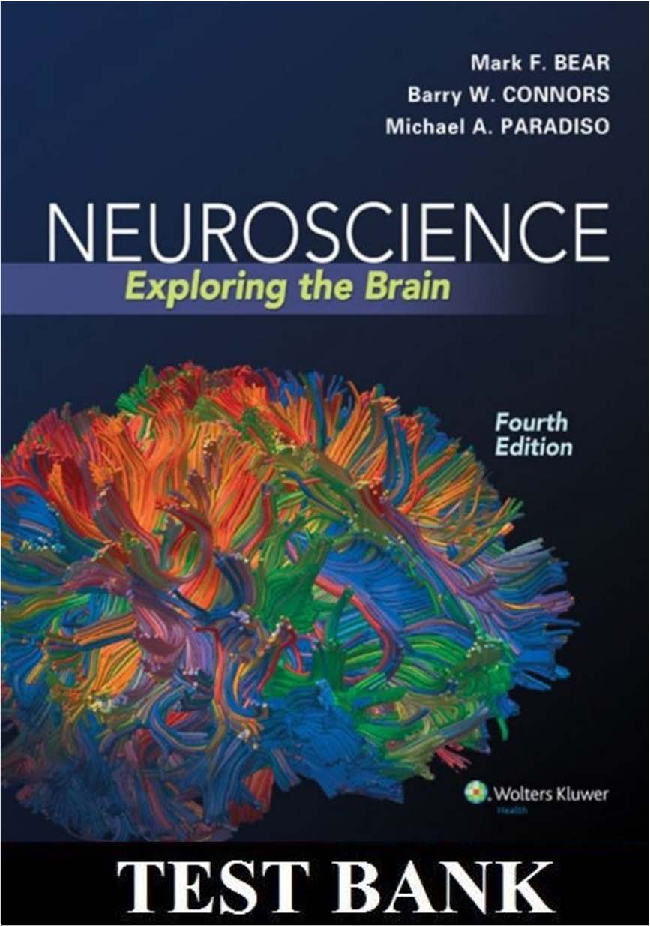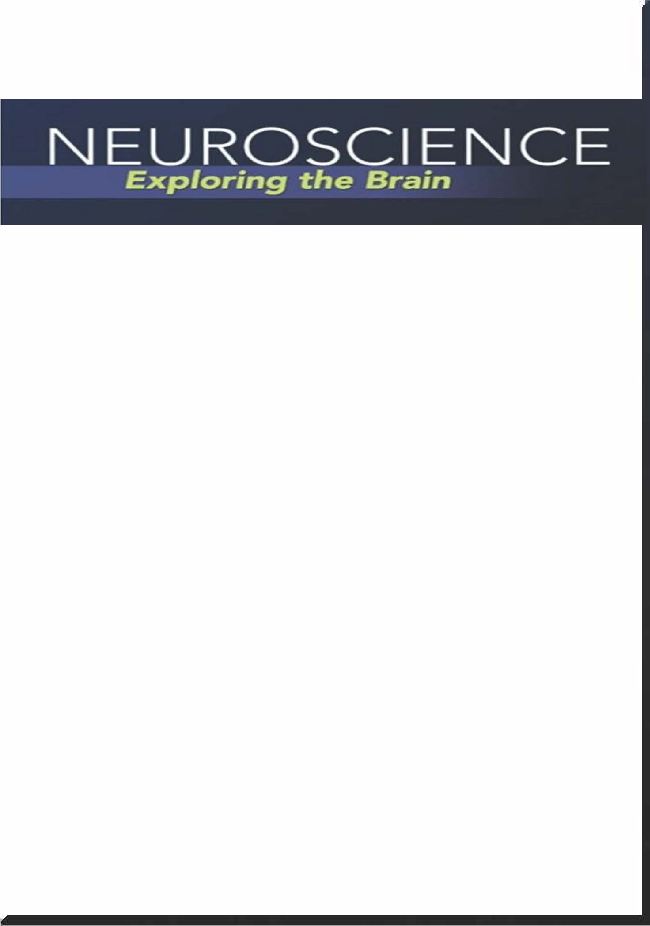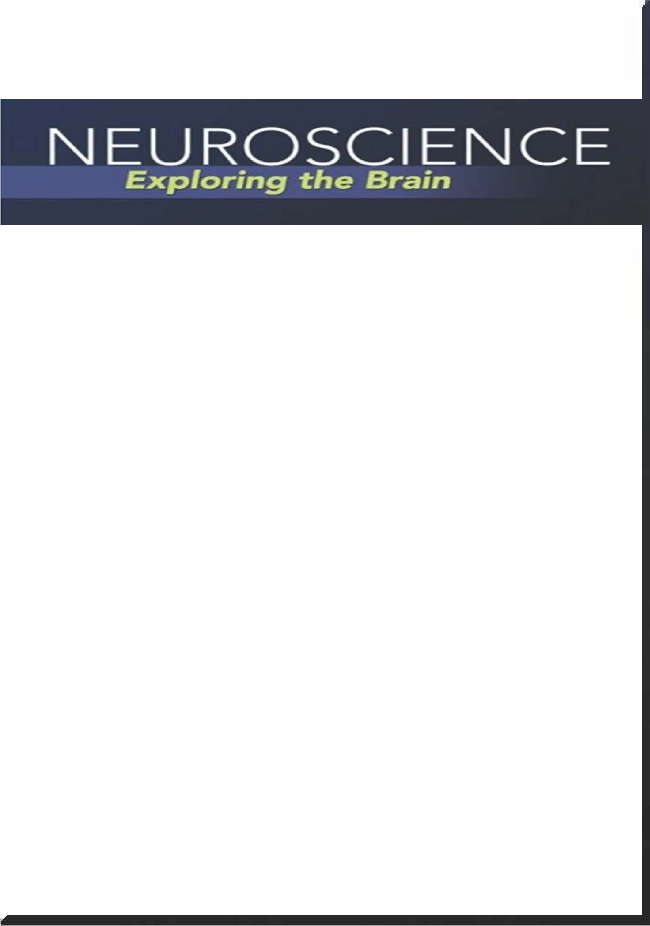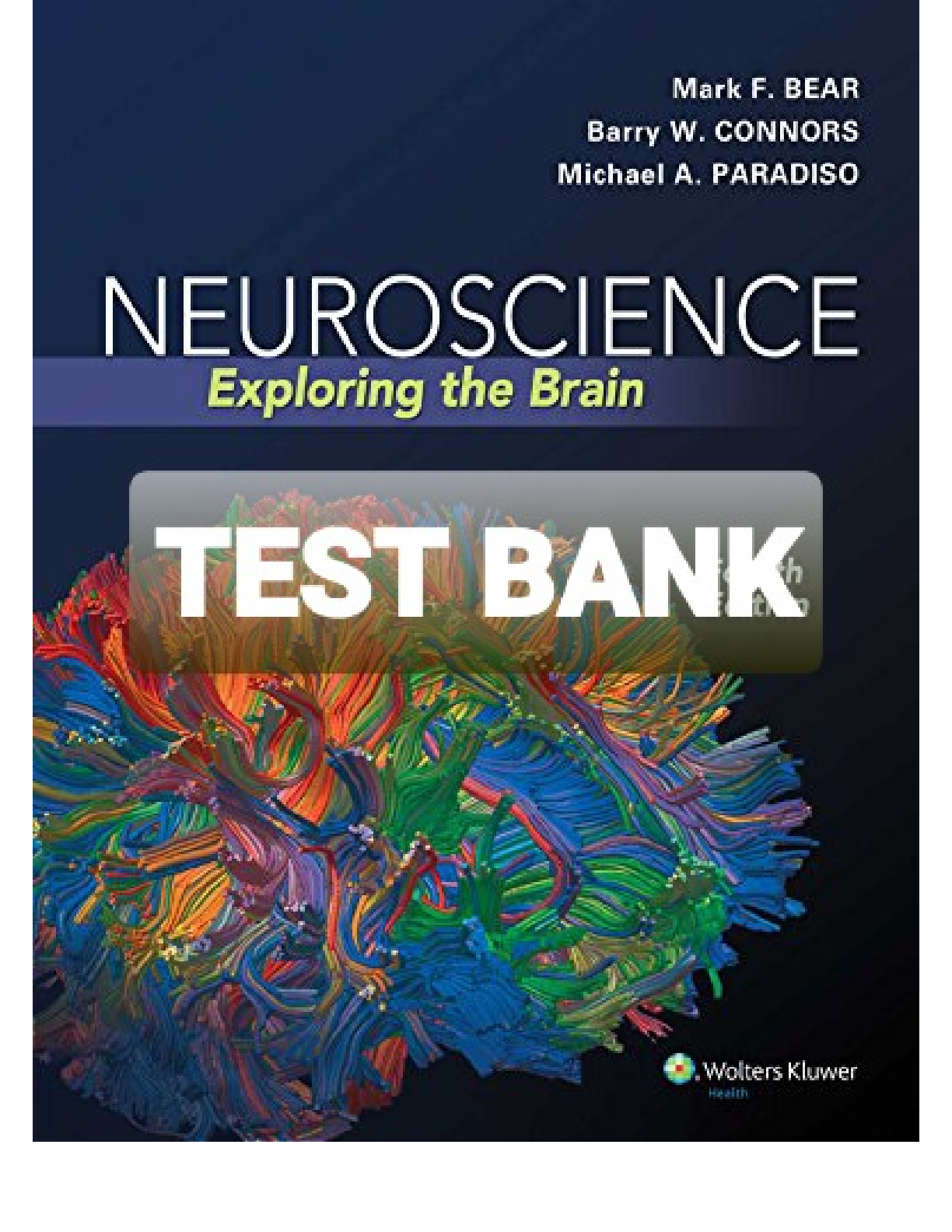Social Sciences > TEST BANK > Test Bank Neuroscience Exploring the Brain 4th Edition by Bear (All chapters complete, Answer key at (All)
Test Bank Neuroscience Exploring the Brain 4th Edition by Bear (All chapters complete, Answer key at every chapter end)
Document Content and Description Below
Test Bank Neuroscience Exploring the Brain 4th Edition by Bear (All chapters complete, Answer key at every chapter end) Neuroscience Exploring the Brain 4th Edition by Bear 1. Why are a broad perspe... ctive and an interdisciplinary approach required for understanding the brain? Choose the correct option. A) Understanding the brain is a focused area in natural science with the brain serving as the common point of focus. B) Understanding the brain requires knowledge about many things, from the structure of the water molecule to the electrical and chemical properties of the brain. C) Understanding the brain requires the study of the different species of the brain. D) Understanding the brain requires the analysis of one approach at a time to yield a new synthesis. 2. Galen's study of sheep brains was the basis for a theory of brain function that prevailed for almost 1500 years. Which of the following represents this view? Choose the correct option. A) The heart as the center of intellect and the brain as the cooling system B) Localization of brain function in the cerebrum and cerebellum C) Mind–brain duality D) Parceling the cerebrum into lobes 3. What is “mind–brain problem”? Choose the correct option. A) Individually, human mental capacities exist in the mind that is outside the brain. B) The mind is the same as the brain. C) Both animals and people possess intellect and a God-given soul. D) The pineal gland is a spiritual entity. 4. What notion was displaced by the concept of nerves being described as wires? Choose the correct option. A) Nerves are channels that communicate with the brain by the movement of fluids. B) Muscles can be twitched when nerves are stimulated electrically and the brain itself may generate electricity. C) Signals to the muscles causing movement use the same wires as those that register sensations from the skin. D) Nerves conduct electrical signals to and from the brain. 5. The combined work of Bell and Magendie revealed a fundamental fact about the spinal nerves. Choose the correct option. A) Spinal nerves are myelinated. B) Spinal nerves are bundles of sensory and motor nerves, and in each sensory and motor nerve fiber, transmission is strictly one-way. C) Spinal nerves are not hollow tubes carrying fluid. D) Both humans and animals have spinal nerves. Page 2 6. For what purpose did Franz Joseph Gall study the dimensions of the human head? Choose the correct option. A) To understand the propensity for certain personality traits B) To demonstrate equal participation of all regions of the brain in all cerebral functions C) To show that nerves conduct electrical signals to and from the brain D) To show that unique human mental capabilities exist outside the brain 7. On what basis did Broca defend functional localization of the brain? Choose the correct option. A) By establishing a relationship between the production of speech and the right frontal lobe B) By establishing a relationship between the production of speech and the occipital lobe C) By establishing a relationship between the production of speech and the left frontal lobe D) By establishing a relationship between the production of speech and the cerebellum 8. To whom can we attribute the theory that behavior is among the heritable traits that can develop? Choose the correct option. A) Marie-Jean-Pierre Flourens B) Charles Darwin C) Gustav Fritsch and Edward Hitzig D) Franz Joseph Gall 9. Which of the following is a correct explanation of a disorder that affects the nervous system? Choose the correct option. A) Cerebral palsy is a motor disorder caused by damage to the cerebrum before, during, or soon after birth. B) Epilepsy is a progressive disease that affects nerve conduction, characterized by episodes of weakness, lack of coordination, and speech disturbance. C) Stroke involves a loss of feeling and movement caused by traumatic damage to the spinal cord. D) Alzheimer's disease is a severe psychotic illness characterized by delusions, hallucinations, and bizarre behavior. Page 3 10. A neuroscientist is investigating how different neural circuits in the brain analyze sensory information, form perceptions of the external world, make decisions, and execute movements. At what level of analysis is this research conducted? Choose the correct option. A) Molecular neuroscience level B) Cellular neuroscience level C) Systems neuroscience level D) Cognitive neuroscience level 11. What is the rationale behind the use of animal models to understand the human brain? Choose the correct option. A) Animal brains are identical to human brains but only smaller in size. B) Brain mechanisms that motivate any reaction are identical in animal and human brains. C) The nervous systems of different species of animals and humans share many common mechanisms. D) Animal brains are easier to obtain than human brains. 12. How do neuroscientists identify the parts of the brain that are specialized for different behavioral functions related to the niche a species normally occupies? Choose the correct option. A) By studying the similarities in response pattern to fear in different species B) By studying neurons one at a time C) By comparing the specializations of the brains of different species D) By systematically destroying each part of the brain and studying its implication 13. At which level of analysis do neuroscientists study the different types of neurons and their functions? Choose the correct option. A) Cellular neuroscience B) Cognitive neuroscience C) Molecular neuroscience D) Behavioral neuroscience 14. What is the difference between replication and verification? Choose the correct option. A) Replication tests a hypothesis, whereas verification rechecks the hypothesis. B) Replication can only be done once, whereas verification can be done many times. C) Replication is repeating the experiment in other subjects to rule out the possibility of chance. In verification, the experiment is repeated and the same observations are obtained by any scientist following the same protocol as the original observer. D) Replication and verification are not essentially different. Page 4 15. Galen suggested that the cerebrum, which was soft, should be the recipient of sensations. He was of the view that to form memories, sensations should be imprinted onto the brain. Thus, this must occur in the doughy cerebrum. Although the conclusion is right, the reason suggested by Galen is incorrect. True or false? A) True B) False 16. Scientists during the seventeenth and eighteenth centuries proposed the structure–function relationship between the white matter and gray matter in the brain. According to this relationship, gray matter contained the fibers that bring information to and from the white matter. True or false? A) True B) False 17. Rats are considered valuable models for the effects of psychoactive drugs on the nervous system. True or false? A) True B) False 18. The Institutional Animal Care and Use Committee is formed of the animal rights representatives. True or false? A) True B) False 19. Scientists use a _______________ approach to understand how the brain works. In this approach, neuroscientists break a complex problem into ___________ pieces for systematic experimental analysis. 20. The process of verification, if __________, establishes new scientific fact or, if __________, suggests new interpretations for the original observation. Page 5 Answer Key 1. B 2. B 3. A 4. A 1. What does the “neuron doctrine” state? Choose the correct option. A) Neurites of different cells fuse together to form a continuous reticulum. B) Individual cells communicate by contact and not continuity. C) The cell body of a neuron contains organelles. D) The elementary functional unit of all tissues is the individual cell. 2. What is a primary function of MAPs? Choose the correct option. A) Regulate the function and assembly of microtubules B) Regulate the function and assembly of microfilaments C) Regulate the function and assembly of neurofilaments D) Regulate the function and assembly of cytoskeleton 3. Neurons comprise two main structures: axons and dendrites. What is a major difference between the two? Choose the correct option. A) Dendrites are of uniform diameter throughout, whereas axons taper to a point. B) Dendrites receive incoming signals from other neurons, whereas axons carry the output of neurons. C) A cell body gives rise to a single dendrite and multiple axons. D) Dendrites travel long distances, whereas axons are always short. 4. A scientist looks through a microscope at the structure of a neuron. The scientist notices a layer of molecules separating the neuron's intracellular space from the extracellular space. What is this part of the neuron known as? Choose the correct option. A) Organelle B) Soma C) Neuronal membrane D) Nuclear envelope 5. What do you understand by the term translation? Choose the correct option. A) Assembling a piece of mRNA B) Assembling proteins from amino acids C) Removal of introns and specific exons D) The “reading” of DNA 6. What is the most important function of the rough endoplasmic reticulum? Choose the correct option. A) RNA splicing B) Post-translational protein processing C) Site of protein synthesis D) Cellular respiration Page 2 7. What does the mitochondrion “inhale”? Choose the correct option. A) Pyruvic acid B) Cytosol C) Adenosine triphosphate D) Amino acids 8. Identify an important difference between the cytoplasm of the axon and that of the axon terminal. Choose the correct option. A) Axon terminals have more microtubules. B) The axon has more synaptic vesicles than the axon terminal. C) Ribosomes are present in the axon terminal. D) There are large numbers of mitochondria in the axon terminal. 9. What is the function of a neurotransmitter receptor in the dendritic membrane? Choose the correct option. A) Release synaptic vesicles B) Detect neurotransmitters C) Destroy extra neurotransmitter left in the synaptic cleft D) Form gap junctions 10. Identify the protein that helps anterograde transport move materials from the soma to the terminal. Choose the correct option. A) Dynein B) Kinesin C) Pyruvic acid D) MAP 11. Which of the following is the largest of the cytoskeletal elements? Choose the correct option. A) Microfilament B) Neurofilament C) Microtubule D) Tubulin 12. What is retrograde axoplasmic transport? Choose the correct option. A) Movement of material from axon terminal to soma B) Movement of material from soma to axon terminal C) Movement of material within the synaptic terminal D) Movement of material among axon collaterals Page 3 13. Some neurons have long axons that stretch from one part of the CNS to another. What are these called? Choose the correct option. A) Interneurons B) Golgi type II neurons C) Golgi type I neurons D) Motor neurons 14. What is the region where the axon begins? Choose the correct option. A) Soma B) Axon hillock C) Axon collateral D) Axon terminal 15. Molecular neurobiologists study the information contained in genes to determine the structure and functions of the neuronal proteins. True or false? A) True B) False 16. Dendritic spines are sensitive to the quality of the environment experienced during early development. True or false? A) True B) False 17. During transcription, transcription factors regulate the process of binding RNA polymerase to the promoter to initiate RNA synthesis. True or false? A) True B) False 18. Ribosomes take raw material in the form of amino acids and manufacture proteins using the blueprint provided by the mRNA. True or false? A) True B) False 19. Free ribosomes that appear to be attached by a thread are called polyribosomes. The thread is a single strand of ______________. Page 4 20. Pathological changes in axonal microtubule-associated proteins (MAPs) are called tau. This pathological change is implicated in the dementia that accompanies ____________. Page 5 Answer Key 1. B 2. A 3. B 4. C [Show More]
Last updated: 11 months ago
Preview 1 out of 126 pages
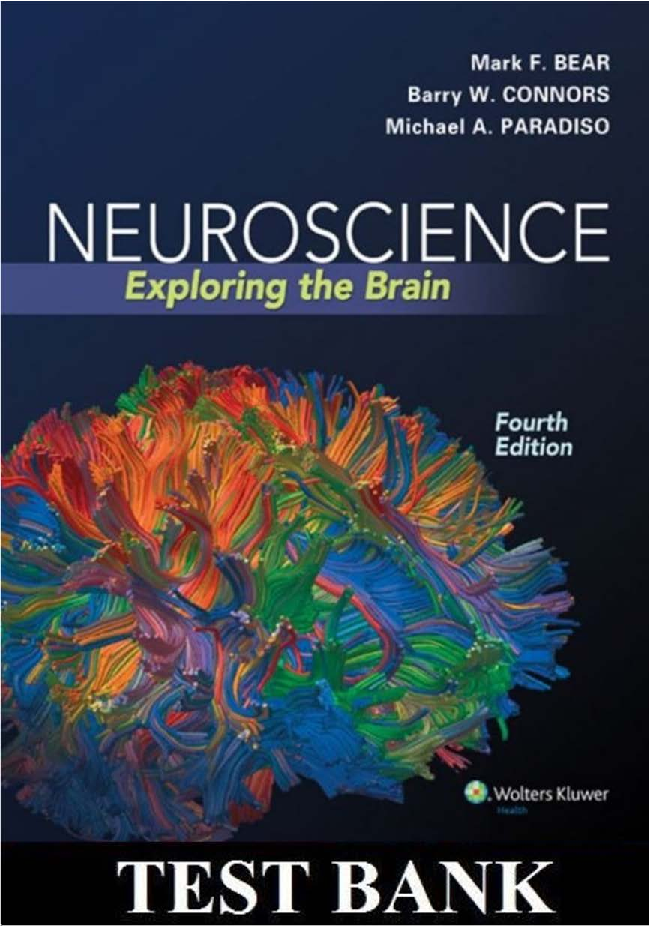
Reviews( 0 )
Document information
Connected school, study & course
About the document
Uploaded On
Sep 08, 2021
Number of pages
126
Written in
Additional information
This document has been written for:
Uploaded
Sep 08, 2021
Downloads
0
Views
93

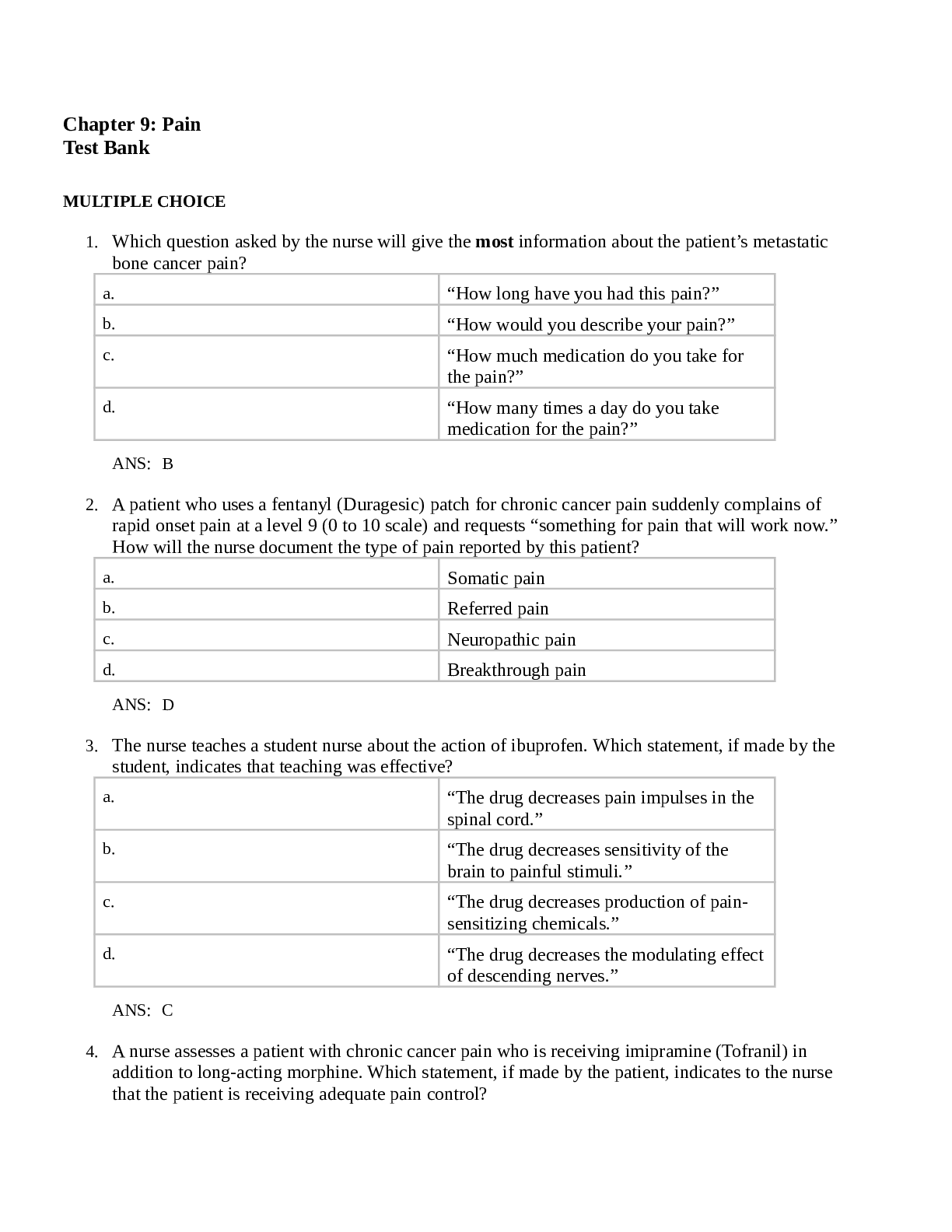
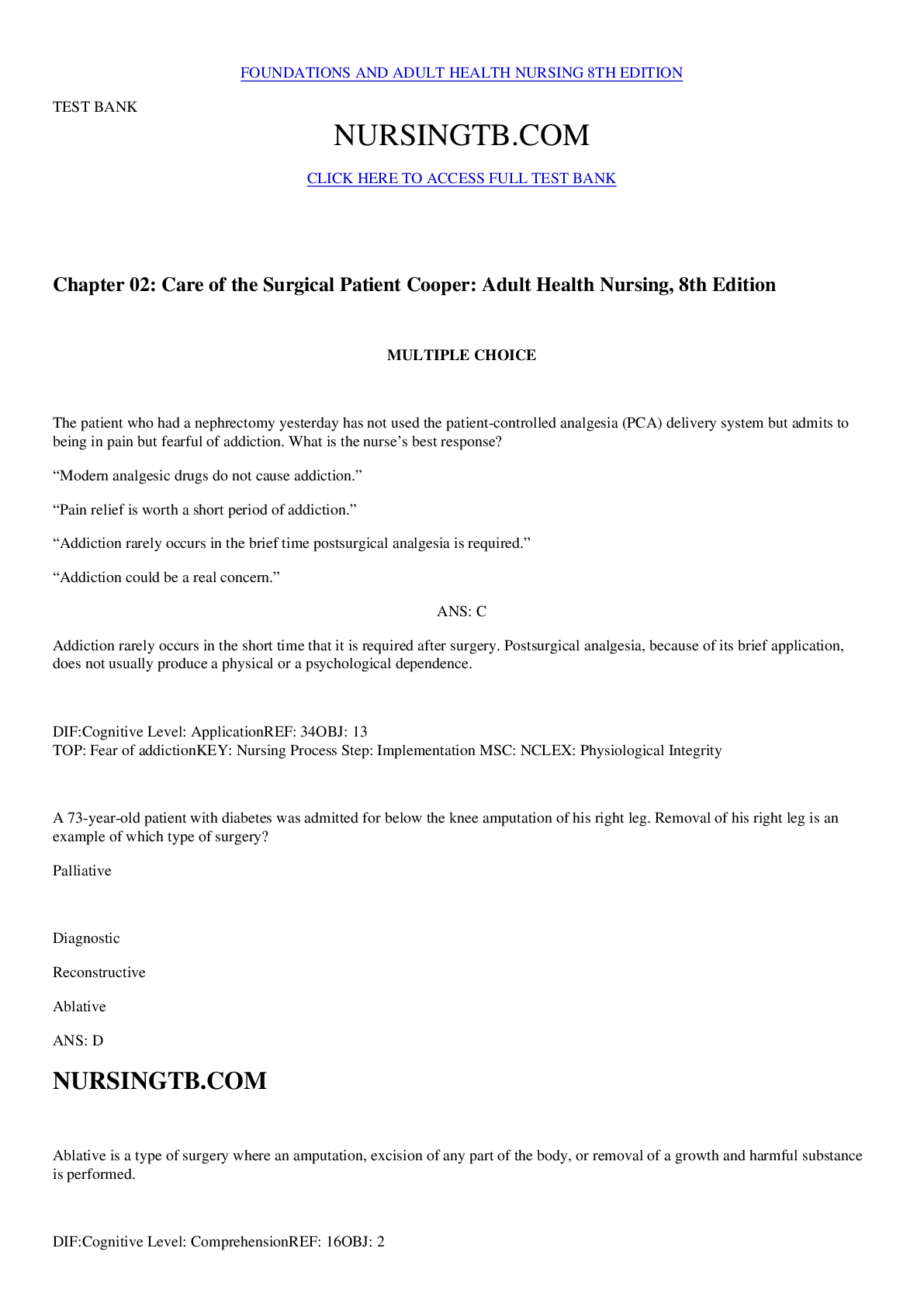
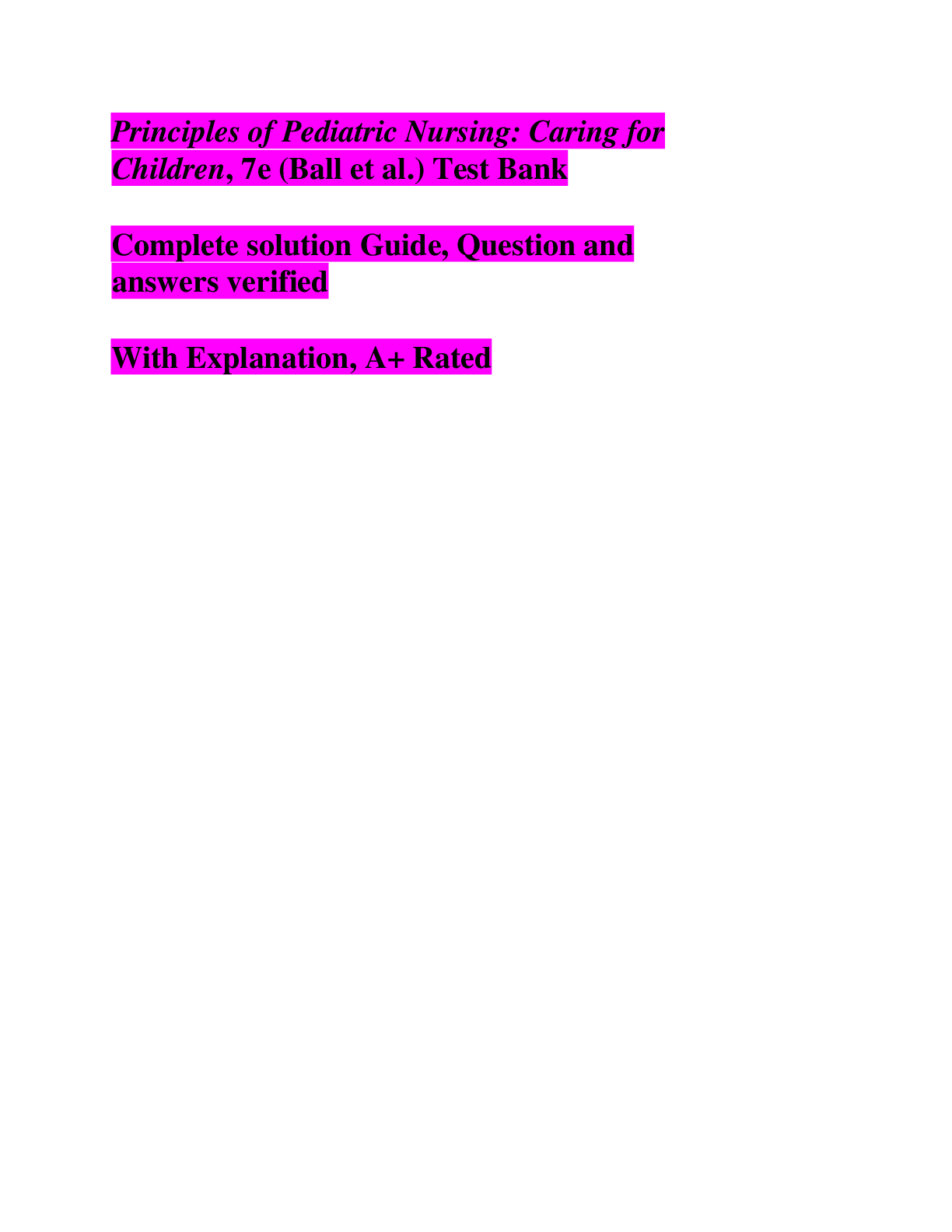

.png)
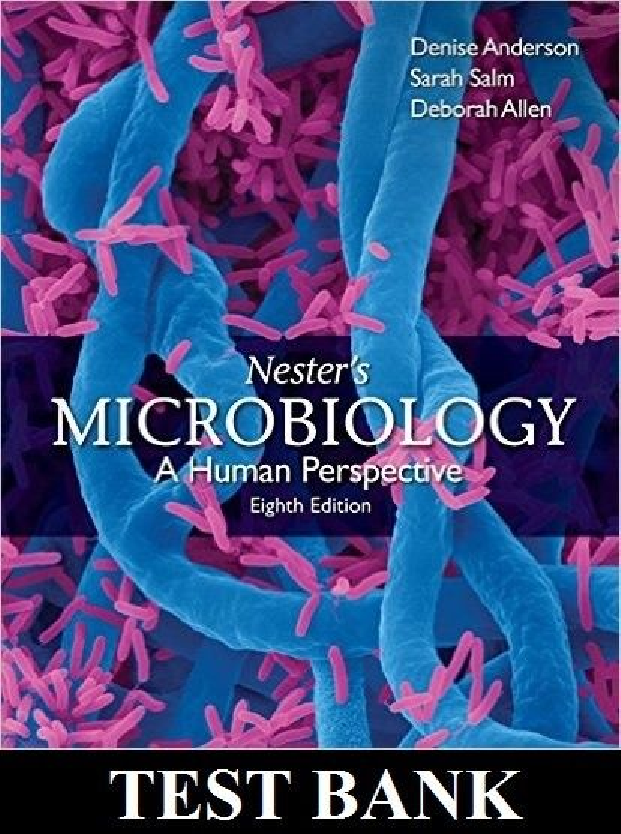

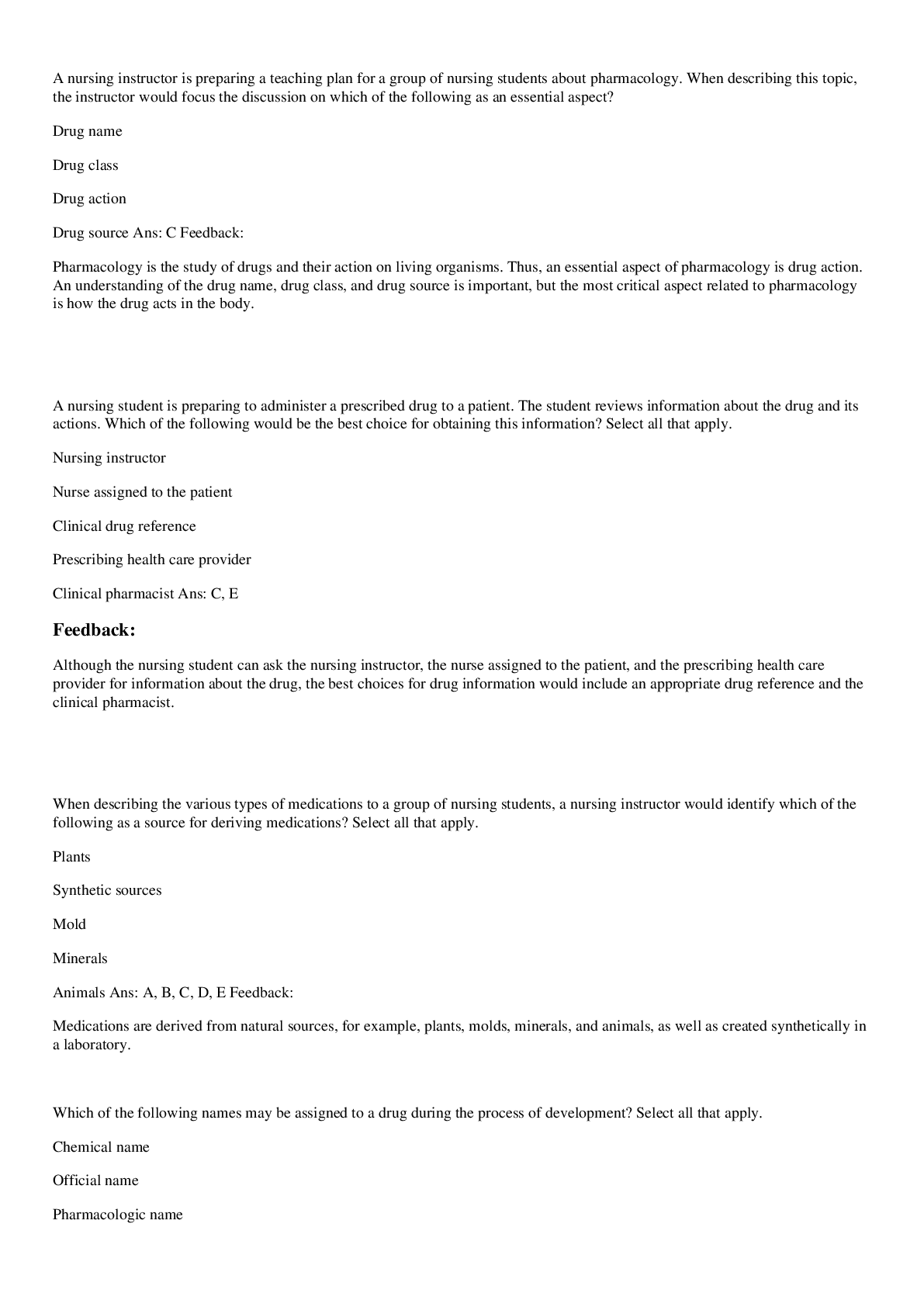

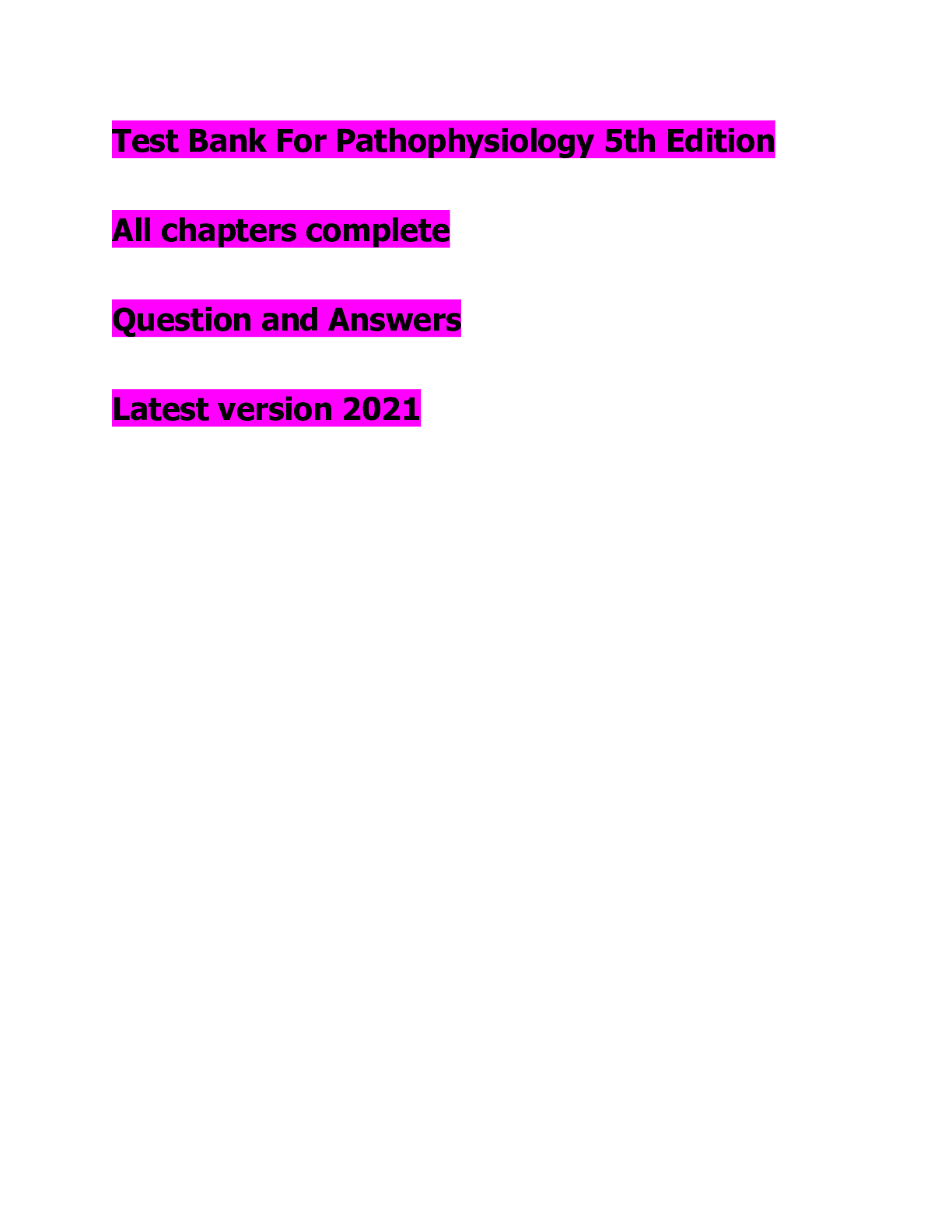
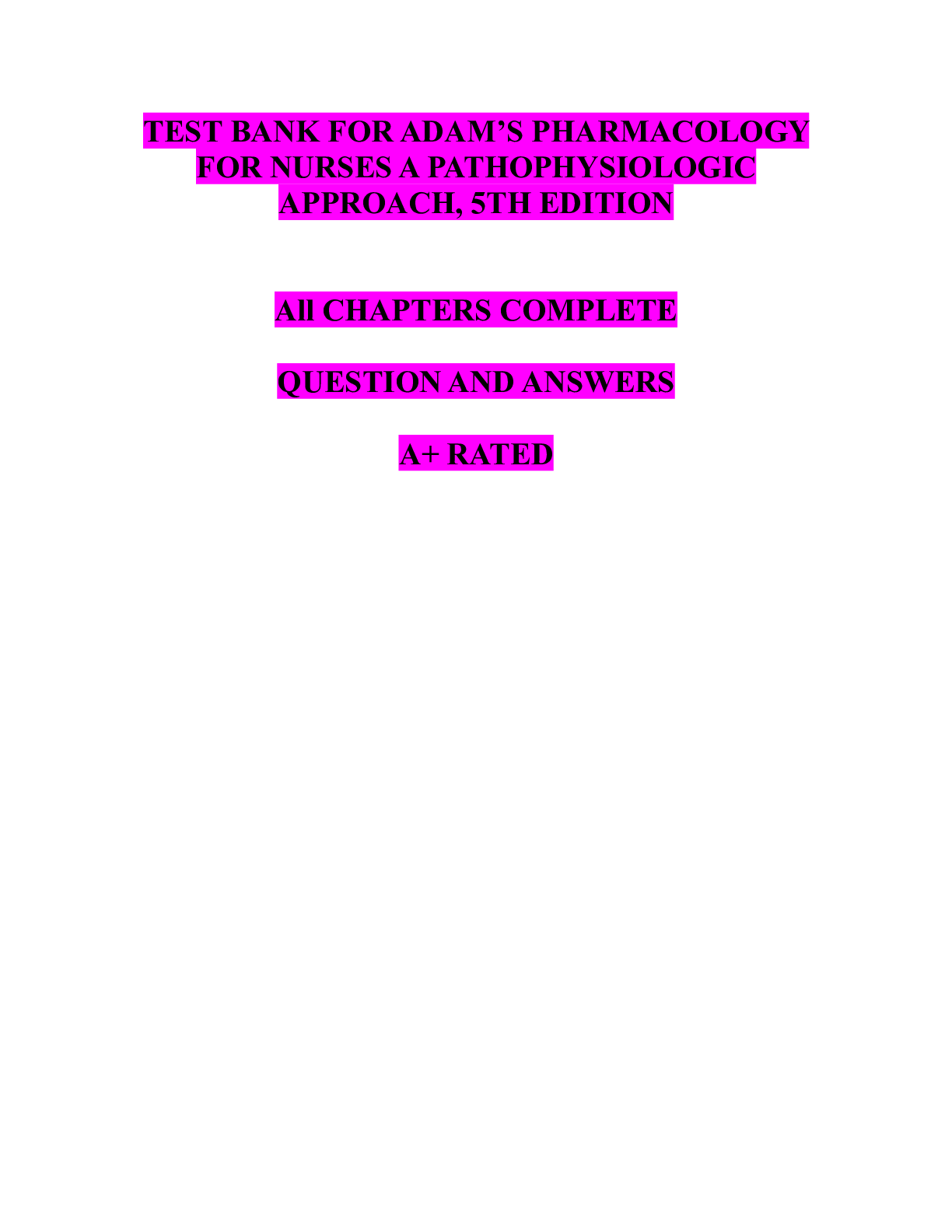
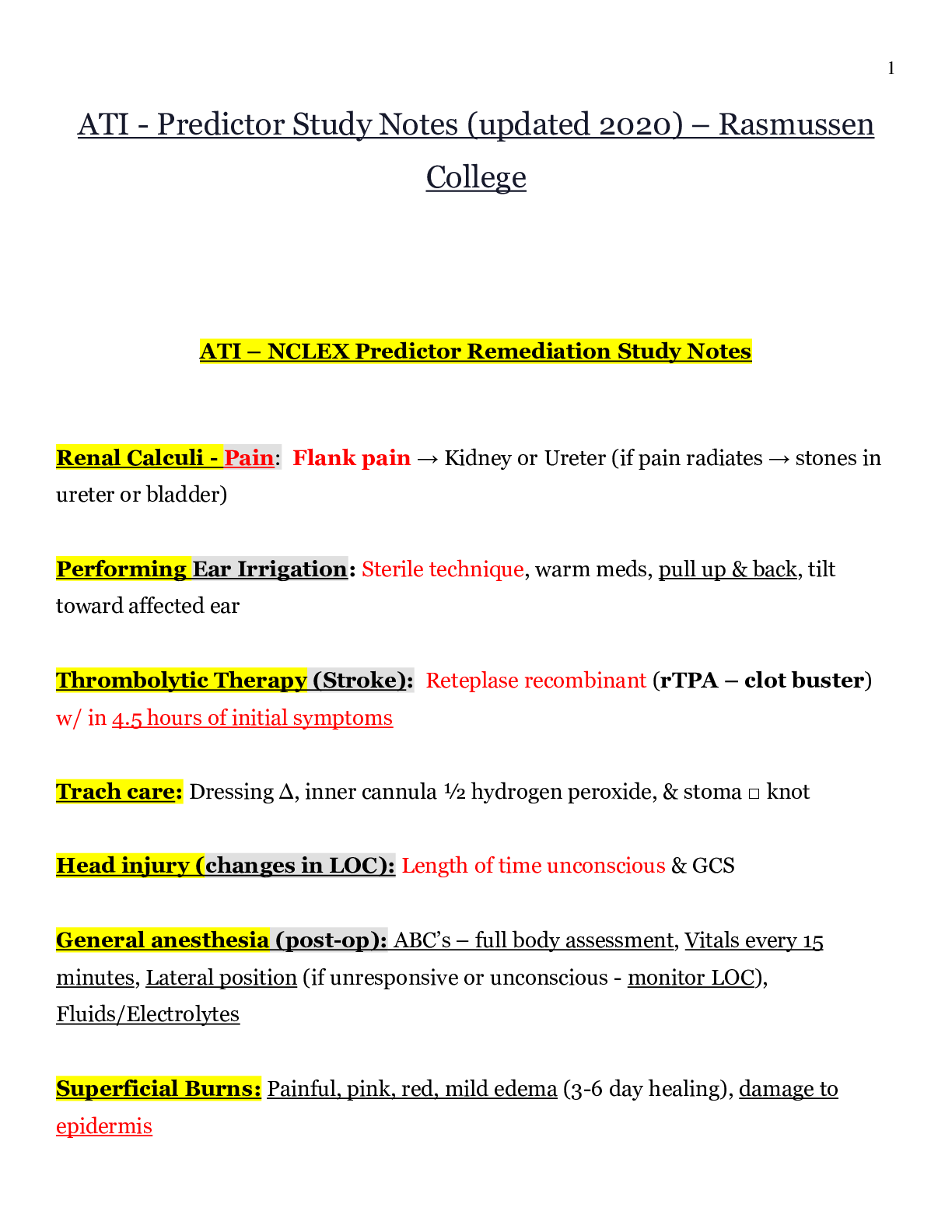

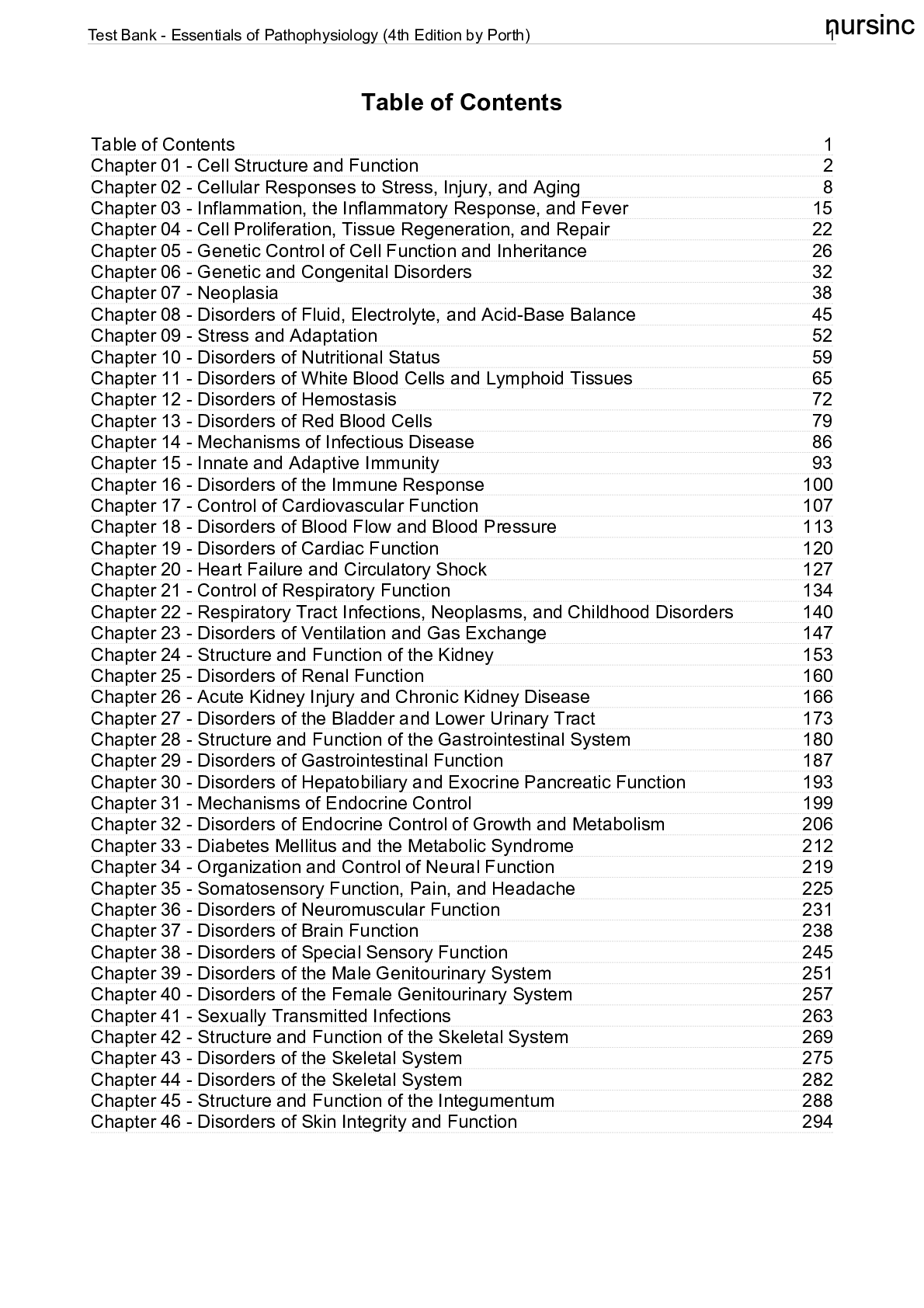

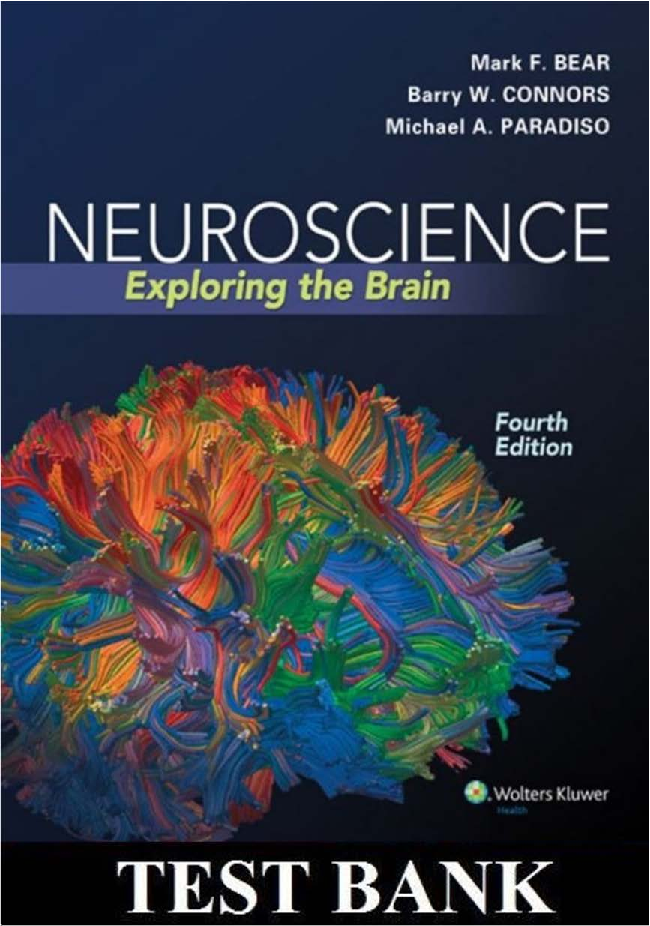
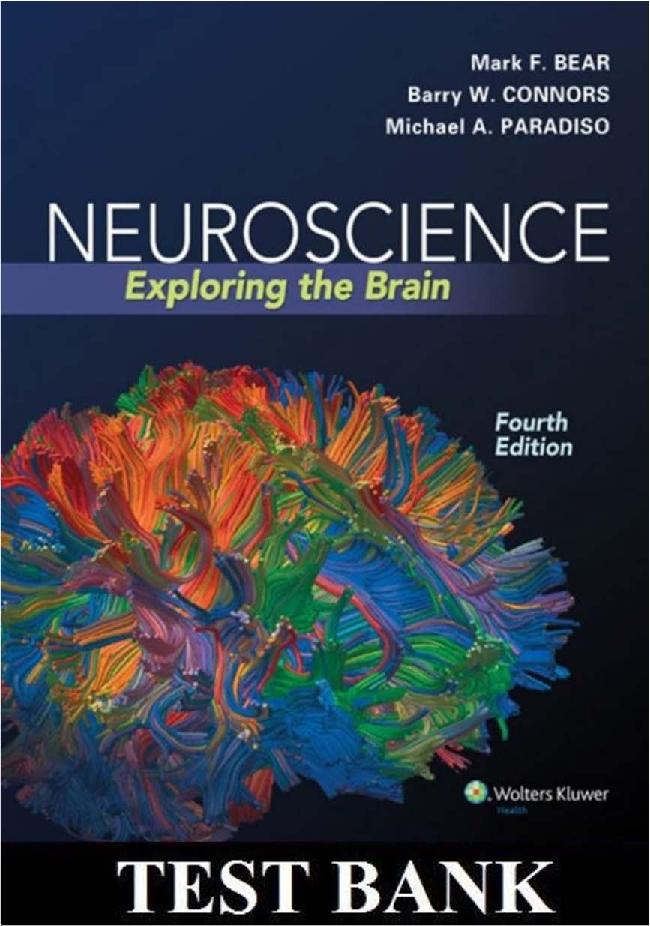

 Mark F.png)


.png)

 MARK F.png)
